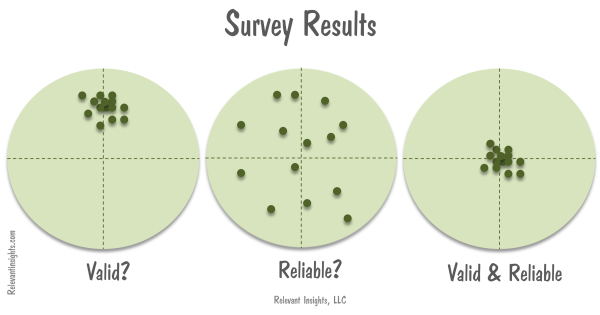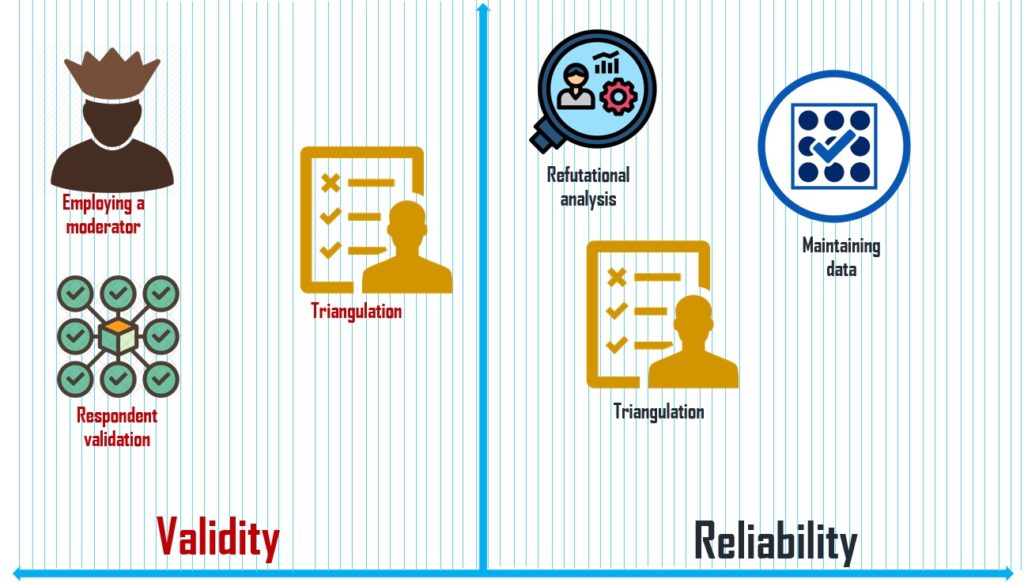When you do quantitative research you have to consider the reliability and validity of your research methods and instruments of measurement. The PJHQ pilot study also had some limi-tations.
 The Methods To Establish Validity And Reliability Of Measures Download Scientific Diagram
The Methods To Establish Validity And Reliability Of Measures Download Scientific Diagram
Often validity and reliability are viewed as completely separate ideas.

How to establish reliability and validity. Content Validity Evidence- established by inspecting a test question to see whether they correspond to what the user decides should be covered by the test. The reactivity should be minimized at the first concern. When you apply the same method to the same sample under the same conditions you should get the same results.
The reliability and validity of a measure can only be established by observing a pattern of results obtained from more than one study. All of these activities are integral components of qualitative inquiry that insure rigor. Reliability tells you how consistently a method measures something.
The intervals between the pre-test and post-test. Validity refers to the degree to which an instrument accurately measures what. Any evidence to be considered should cover the reliability of the measure.
We can get high reliability and low validity. For example a survey designed to explore depression but which actually measures anxiety would not be. Understanding and Testing Validity.
2113 inpa-tients discharged from 10 hospitals 8 which were located in the Southwest. Second it was based on a small sample. Whether quantitative or qualitative methods are.
A proper functioning method to ensure validity is given below. A good questionnaire should be able to establish qualities of reliability and validity for it to be able to produce correct information concerning a particular topic. The respondents should be motivated.
METHODS TO ESTABLISH VALIDITY AND RELIABILITY by Albert Barber 1. Establish the reliability and validity of the 6 scales developed from the questionnaire. Makes and measures objectives 2.
Reliability refers to the consistency of the measurements or the degree to which an instrument measures the same with every use under the exact same conditions. The Hawthorne effect should be reduced. Our argument is based on the premise that the concepts of reliability and validity as overarching constructs can be appropriately used in all scientific paradigms because as Kvale 1989 states to validate is to investigate to check to question and to theorize.
Study approach which includes both the validity and reliability dimensions is a fundamental element so that the findings obtained by the case. Rigour refers to the extent to which the researchers worked to enhance the quality of the studies. Criterion-Related Validity Evidence- measures the legitimacy of a new test with that of an old test.
How to ensure validity and reliability in your research. Reliability is needed but not sufficient to establish validity. If a questionnaire used to conduct a study lacks these two very important characteristics then the conclusion drawn from that particular study can be referred to as invalid.
This often means the study needs to be conducted again. How to Determine the Validity and Reliability of an Instrument By. Validity and reliability are two important factors to consider when developing and testing any instrument e.
The reliability and validity of your results depends on creating a strong research design choosing appropriate methods and samples and conducting the research carefully and consistently. Third the evidence supporting the independence of the 6. In quantitative research this is achieved through measurement of the validity and reliability1 Validity is defined as the extent to which a concept is accurately measured in a quantitative study.
Let the center of the target represent the construct you intend to measure. Reliability is usually estimated using internal consistency the. If you measure the concept perfectly for a person you hit the.
First the study focused exclusively on acute-care hospital inpatients. To think about how the two are related we can use a target analogy. Also if the results show large variability they may be valid but not reliable.
Rigour in quantitative studies refers to the extent the researchers worked to enhance the quality of the study. For each subject that responds to your survey questionnaire you take a shot at the target. Validity refers to a judgment pegged on several kinds of evidence.
This would happen when we ask the wrong questions over and over again consistently yielding bad information. This is achieved through measurement of reliability and validity.
How To Determine The Validity And Reliability Of An Instrument Discovery Center For Evaluation Research Professional Learning
 Principles And Methods Of Validity And Reliability Testing Of Questionnaires Used In Social And Health Science Researches Bolarinwa Oa Niger Postgrad Med J
Principles And Methods Of Validity And Reliability Testing Of Questionnaires Used In Social And Health Science Researches Bolarinwa Oa Niger Postgrad Med J
 The Concepts Of Reliability And Validity Explained With Examples Psychologenie
The Concepts Of Reliability And Validity Explained With Examples Psychologenie
 Principles And Methods Of Validity And Reliability Testing Of Questionnaires Used In Social And Health Science Researches Bolarinwa Oa Niger Postgrad Med J
Principles And Methods Of Validity And Reliability Testing Of Questionnaires Used In Social And Health Science Researches Bolarinwa Oa Niger Postgrad Med J
 Validity And Reliability In Surveys Relevant Insights
Validity And Reliability In Surveys Relevant Insights
 Reliability Validity Explained Youtube
Reliability Validity Explained Youtube
Reliability And Validity Aldenham Psychology
 Validity And Reliability Of Case Study Research Yin 2003 Download Table
Validity And Reliability Of Case Study Research Yin 2003 Download Table
 How To Establish The Validity And Reliability Of Qualitative Research
How To Establish The Validity And Reliability Of Qualitative Research
 The Methods To Establish Validity And Reliability Of Measures Download Scientific Diagram
The Methods To Establish Validity And Reliability Of Measures Download Scientific Diagram
 Validity And Reliability In Instrumentation Ppt Video Online Download
Validity And Reliability In Instrumentation Ppt Video Online Download
 Chapter 7 Scale Reliability And Validity Research Methods For The Social Sciences
Chapter 7 Scale Reliability And Validity Research Methods For The Social Sciences
 How Can One Establish The Validity And Reliability Of A Formative Construct
How Can One Establish The Validity And Reliability Of A Formative Construct
